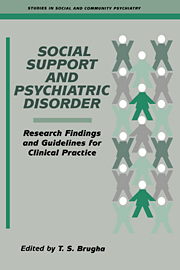Book contents
- Frontmatter
- Contents
- Preface
- List of contributors
- 1 Social support and psychiatric disorder: overview of evidence
- PART I CONCEPTS AND ORIGINS OF SOCIAL SUPPORT
- PART II LESSONS FROM SELECTED OBSERVATIONAL STUDIES
- PART III LESSONS FROM INTERVENTION STUDIES
- 9 Social network and mental health: an intervention study
- 10 A test of the social support hypothesis
- 11 Case management and network enhancement of the long-term mentally ill
- 12 Expressed Emotion: measurement, intervention and training issues
- PART IV INTERVENTION PRINCIPLES AND RECOMMENDATIONS
- Index
9 - Social network and mental health: an intervention study
from PART III - LESSONS FROM INTERVENTION STUDIES
Published online by Cambridge University Press: 31 October 2009
- Frontmatter
- Contents
- Preface
- List of contributors
- 1 Social support and psychiatric disorder: overview of evidence
- PART I CONCEPTS AND ORIGINS OF SOCIAL SUPPORT
- PART II LESSONS FROM SELECTED OBSERVATIONAL STUDIES
- PART III LESSONS FROM INTERVENTION STUDIES
- 9 Social network and mental health: an intervention study
- 10 A test of the social support hypothesis
- 11 Case management and network enhancement of the long-term mentally ill
- 12 Expressed Emotion: measurement, intervention and training issues
- PART IV INTERVENTION PRINCIPLES AND RECOMMENDATIONS
- Index
Summary
Introduction
The first two chapters in Part III have been included to provide readers with a deeper understanding of the benefits of and the challenges posed by conducting experimental intervention studies. In this chapter we describe a preventive programme aimed at improving mental health by improving social networks, which was carried out in a recently established working-class/middle-class neighbourhood with mainly high-rise houses on the outskirts of Oslo, Norway (‘satellite town’). The target group was middle-aged women with poor social networks, low quality of life and a high load of stress symptoms, identified by a survey of a representative sample of middle-aged women in the neighbourhood.
As shown in a previous study from Oslo (Dalgard, 1986), having a qualitatively poor social network increases the risk of mental disorder, especially when living in a new and poorly integrated neighbourhood. Being a woman, especially when middle-aged, adds to this risk (Dalgard, 1980). However, it can not be decided, on the basis of such a cross-sectional study, to what extent a poor social network contributes to the development of mental disorder, possibly as a vulnerability factor, or rather is a consequence of poor mental health. Longitudinal studies and intervention studies are necessary to shed more light on this question. The present chapter describes an intervention project, designed on the basis of the epidemiological study referred to above.
Keywords
- Type
- Chapter
- Information
- Social Support and Psychiatric DisorderResearch Findings and Guidelines for Clinical Practice, pp. 197 - 212Publisher: Cambridge University PressPrint publication year: 1995
- 4
- Cited by

